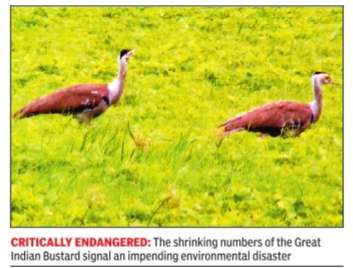Great Indian Bustard
(Created page with "{| class="wikitable" |- |colspan="0"|<div style="font-size:100%"> This is a collection of articles archived for the excellence of their content.<br/> </div> |} [[Category:Ind...") |
|||
| Line 3: | Line 3: | ||
|colspan="0"|<div style="font-size:100%"> | |colspan="0"|<div style="font-size:100%"> | ||
This is a collection of articles archived for the excellence of their content.<br/> | This is a collection of articles archived for the excellence of their content.<br/> | ||
| + | Additional information may please be sent as messages to the Facebook <br/>community, [http://www.facebook.com/Indpaedia Indpaedia.com]. All information used will be gratefully <br/>acknowledged in your name. | ||
</div> | </div> | ||
|} | |} | ||
[[Category:India |B ]] | [[Category:India |B ]] | ||
| − | [[Category:Fauna |B]] | + | [[Category:Fauna |B ]] |
| + | =Population= | ||
| + | ==2014: less than 200== | ||
''' Great Indian Bustard flying into extinction ''' | ''' Great Indian Bustard flying into extinction ''' | ||
| Line 14: | Line 17: | ||
Bengaluru: | Bengaluru: | ||
| − | [[File: Great Indian Bustard.jpg| Great Indian Bustard |frame|500px]] | + | [[File: The shrinking numbers of Great Indian Bustard signal an impending environmental disaster.jpg|The shrinking numbers of Great Indian Bustard signal an impending environmental disaster; <br/> From: Saswati Mukherjee [http://epaperbeta.timesofindia.com/Article.aspx?eid=31808&articlexml=Great-Indian-Bustard-flying-into-extinction-17112014011014 ''The Times of India''] Nov 17 2014|frame|500px]] |
| − | |||
| − | Less Than 200 Left, Figure In Endangered List | + | '''RAMPANT POACHING & HABITAT LOSS MAKE BIRDS VANISH FROM COUNTRY''' |
| + | |||
| + | ''Less Than 200 Left, Figure In Endangered List'' | ||
| + | |||
The majestic Great Indian Bustards (GIBs) are vanishing from sight and their dwindling numbers have put them in the International Union for Conservation of Nature’s (IUCN) critically endangered category (red list). According to estimates, less than 200 GIBs are left in the country now. | The majestic Great Indian Bustards (GIBs) are vanishing from sight and their dwindling numbers have put them in the International Union for Conservation of Nature’s (IUCN) critically endangered category (red list). According to estimates, less than 200 GIBs are left in the country now. | ||
Revision as of 06:59, 19 January 2019
This is a collection of articles archived for the excellence of their content. |
Population
2014: less than 200
Great Indian Bustard flying into extinction
Saswati Mukherjee The Times of India Nov 17 2014 Bengaluru:

From: Saswati Mukherjee The Times of India Nov 17 2014
RAMPANT POACHING & HABITAT LOSS MAKE BIRDS VANISH FROM COUNTRY
Less Than 200 Left, Figure In Endangered List
The majestic Great Indian Bustards (GIBs) are vanishing from sight and their dwindling numbers have put them in the International Union for Conservation of Nature’s (IUCN) critically endangered category (red list). According to estimates, less than 200 GIBs are left in the country now.
A huge bird with a horizontal body and long, bare legs, the GIB looks like an ostrich. Among the heaviest of flying birds, they were once endemic to the dry plains of India, abundantly found in the Ranebennur region of central Karnataka. Their population has dwindled significantly because of habitat loss and rampant poaching.
“GIBs are shrinking by the day; their count has fallen below the 200 mark,” says Mohammed Esmail Dilawar, president and founder, Nature Forever Society, Maharashtra.
S Subramanya, scientist and senior faculty member at University of Agricultural Sciences (UAS), says: “Grasslands in the state are being converted to agriculturally fit land and pressure from real-estate development is immense too. Habitat loss is the obvious consequence.” Experts say a vibrant GIB population is reflective of a healthy ecosystem. The bird’s shrinking numbers signal an impending environmental disaster, they warn. “GIBs are an indicator of a healthy grassland ecosystem,” says Sujit Narwade, project scientist, Bombay Natural History Society. “Grasslands as a forest category support biodiversity dependent on it, ranging from termites and spiders to insects and wolves. Unfortunately, they are usually considered wastelands. Many species exist in the food web and food chain in grassland ecosystems. If one is allowed to vanish, other species too will unknowingly disappear.” Maharashtra, Andhra Pradesh and Karnataka have an estimated population of 10-15 birds each; they can still be spotted in the existing bustard ranges. Gujarat and Rajasthan support a higher number of bustards.
In 2012, the drastic fall in the population of Indian bustards, their endangered status and the decline of grasslands prompted the ministry of environment and forests to draft a species recovery programme for them. Each bustard range state developed site-specific conservation plans, but their implementation has floundered, including of the one in Karnataka.